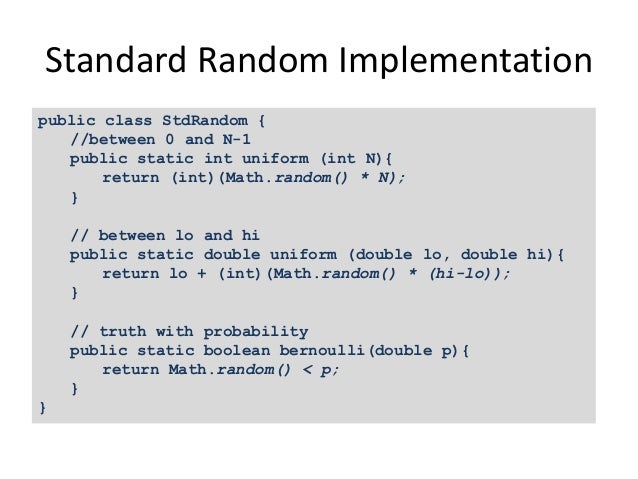

MATH.RANDOM JAVA GENERATOR
You can learn more about the math.random method in Java in our Java random number generator Example. As you can notice, all the parameters take a value that is into their respective range. We can use the same way for negative random numbers etc.įor a better understanding, please look the output of the execution. Also notice that for integer values we should cast the result. Please notice that the random values are always less than this sum – in our example the range is [3,8). Respectively, if we multiply the result with 5 and add number 3, the range has a minimum value number 3 and as maximum value their sum (5+3). For example, if we want a random positive, double number greater than or equal to 0.0 but less than 20.0, we should multiply the result of random() method with the double number 20.0. For generating random integer or double numbers between a range, we should multiply and/or sum the appropriate positive and/or negative values in order to achieve the desired result. Import, we use Java math.random method in order to take a positive signed double value, that belongs to the range [0.0, 0.1). Here is a simple example showing ThreadLocalRandom usage in a multithreaded environment. ThreadLocalRandom in multithreaded environment (Arrays.toString(randomByteArray)) // sample output Ĩ. The number of random bytes produced is equal to the length of the byte array. We can generate random bytes and place them into a user-supplied byte array using Random class.

Generate Random boolean Random random = new Random() Generate Random long Random random = new Random() Ħ. Generate Random float Random random = new Random() ĥ. We can use Math.random() or Random class nextDouble method to generate random double number in java.
MATH.RANDOM JAVA CODE
You can extend the above code to generate the random number within any given range. Also, 0 is included in the generated random number, so we have to keep calling nextInt method until we get a value between 1 and 10. The argument in the nextInt(int x) is excluded, so we have to provide argument as 11.
MATH.RANDOM JAVA HOW TO
Below is the code showing how to generate a random number between 1 and 10 inclusive. For example, in a dice game possible values can be between 1 to 6 only. Sometimes we have to generate a random number between a range. set long seed value using setter method set the long seed value using Random constructor The implementation selects the initial seed to the random number generation algorithm it cannot be chosen or reset by the user. We can set this seed value in the program, however, it’s not required in most of the cases. The Math.random() function returns a floating-point, pseudo-random number in the range 0 to less than 1 (inclusive of 0, but not 1) with approximately uniform distribution over that range which you can then scale to your desired range. When we create the Random instance, it generates a long seed value that is used in all the nextXXX method calls. Yes, it’s that simple to generate a random integer in java. Generating ranges in general: (int)(Math.random() number of options). Generate Random integer Random random = new Random() Write a code segment that will print the number of the winning ticket drawn at random. Later on, we will also look at ThreadLocalRandom and SecureRandom example program. Let’s look at some examples to generate a random number in Java. So depending on your application requirements, you should decide whether to use it or not. This class provides a cryptographically strong random number generator.

It provides several methods to generate random integer, long, double etc.



 0 kommentar(er)
0 kommentar(er)
